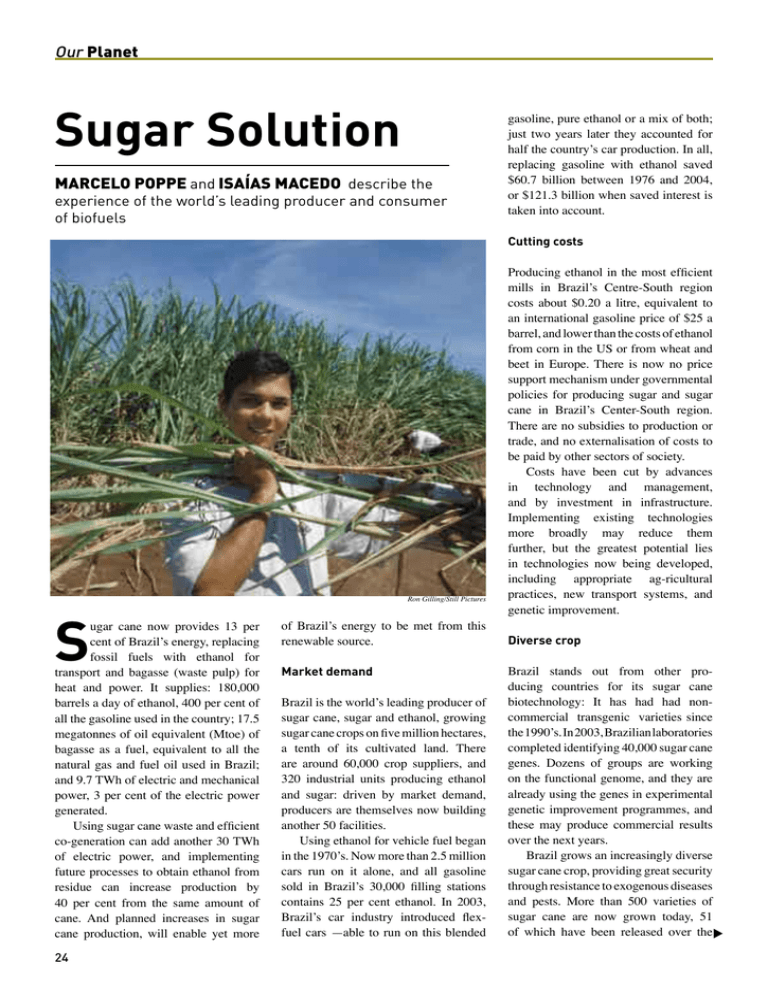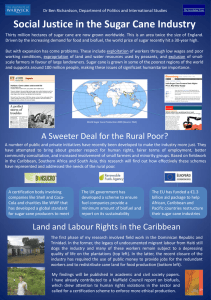Sugar Solution
advertisement

Our Planet Sugar solution Marcelo Poppe and Isaías Macedo describe the experience of the world’s leading producer and consumer of biofuels Ron Gilling/Still Pictures S 24 of Brazil’s energy to be met from this renewable source. Market demand Brazil is the world’s leading producer of sugar cane, sugar and ethanol, growing sugar cane crops on five million hectares, a tenth of its cultivated land. There are around 60,000 crop suppliers, and 320 industrial units producing ethanol and sugar: driven by market demand, producers are themselves now building another 50 facilities. Using ethanol for vehicle fuel began in the 1970’s. Now more than 2.5 million cars run on it alone, and all gasoline sold in Brazil’s 30,000 filling stations contains 25 per cent ethanol. In 2003, Brazil’s car industry introduced flexfuel cars —able to run on this blended Producing ethanol in the most efficient mills in Brazil’s Centre-South region costs about $0.20 a litre, equivalent to an international gasoline price of $25 a barrel, and lower than the costs of ethanol from corn in the US or from wheat and beet in Europe. There is now no price support mechanism under governmental policies for producing sugar and sugar cane in Brazil’s Center-South region. There are no subsidies to production or trade, and no externalisation of costs to be paid by other sectors of society. Costs have been cut by advances in technology and management, and by investment in infrastructure. Implementing existing technologies more broadly may reduce them further, but the greatest potential lies in technologies now being developed, including appropriate ag-ricultural practices, new transport systems, and genetic improvement. Diverse crop Brazil stands out from other producing countries for its sugar cane biotechnology: It has had had noncommercial transgenic varieties since the 1990’s. In 2003, Brazilian laboratories completed identifying 40,000 sugar cane genes. Dozens of groups are working on the functional genome, and they are already using the genes in experimental genetic improvement programmes, and these may produce commercial results over the next years. Brazil grows an increasingly diverse sugar cane crop, providing great security through resistance to exogenous diseases and pests. More than 500 varieties of sugar cane are now grown today, 51 of which have been released over the ▲ ugar cane now provides 13 per cent of Brazil’s energy, replacing fossil fuels with ethanol for transport and bagasse (waste pulp) for heat and power. It supplies: 180,000 barrels a day of ethanol, 400 per cent of all the gasoline used in the country; 17.5 megatonnes of oil equivalent (Mtoe) of bagasse as a fuel, equivalent to all the natural gas and fuel oil used in Brazil; and 9.7 TWh of electric and mechanical power, 3 per cent of the electric power generated. Using sugar cane waste and efficient co-generation can add another 30 TWh of electric power, and implementing future processes to obtain ethanol from residue can increase production by 40 per cent from the same amount of cane. And planned increases in sugar cane production, will enable yet more gasoline, pure ethanol or a mix of both; just two years later they accounted for half the country’s car production. In all, replacing gasoline with ethanol saved $60.7 billion between 1976 and 2004, or $121.3 billion when saved interest is taken into account. Cutting costs Our Planet past decade. The twenty most important varieties occupy 80 per cent of the crop area, but the most common covers just 12.6 per cent of it. Environmental benefits The industry makes an important contribution to cutting local pollution and greenhouse gas emissions (GHG), and to the recovery of agricultural soils. Using ethanol has led to considerable improvements in air quality in urban centres, by eliminating lead from gasoline, reducing carbon monoxide emissions, eliminating sulphur and particulate matter, and emitting less toxic and photochemically reactive organic compounds. It also avoids the equivalent of 13 per cent of the emissions of greenhouse gases from Brazil’s entire energy sector — amounting to the equivalent of 33.2 Mt of carbon dioxide in 2003 alone. Every additional 100 Mt of sugar cane produced in future will cut emissions by a further 12.6 Mt. At present sugar cane occupies just 0.6 per cent of land area, while at least 12 per cent of it could support the expansion of this kind of crop. A large proportion of Brazil’s vast area of 850 million hectares enjoys conditions that will support agricultural production, while still preserving vast forest areas with different biomes. At present agriculture uses only 7 per cent of the country’s territory (half of which is under soybean and corn crops), pastures use 35 per cent and forests 55 per cent. The expansion of sugar cane crops has taken place mostly in degraded pasture and “campos sujos” (grassland with some shrubs), rather than in forest areas. So far sugar cane crops have had virtually no irrigation in Brazil. The amount of water withdrawn, and released, when they are industrially processed, has substantially de-creased from around 5 per cubic metre of per tonne of sugar cane collected in 1990 to 1.8 in 2004. Little fertiliser is used in comparison with sugar cane crops in other countries: 48 per cent more is used in Australia, for example. Nutrient recycling is being optimised, while the use of waste — which has yet to be implemented — will be very useful. specialised jobs There are now 800,000 formal direct jobs in the industry, and the number is increasing; 90.4 per cent of those formally employed are aged 18 to 48, with only 0.3 per cent under 17. People working with sugar cane crops in the Centre-South, earn more than workers with coffee, citrus and corn crops, but less than those with soybean — which is highly mechanized, and provides more specialised jobs. In the North-Northeast, they earn more than those working with coffee, rice, banana, manioc, and corn crops, much the same as workers with citrus crops, and again less than those with soybean crops. Mills maintain more than 600 schools, 200 daycare units and 300 walk-in care units. A survey of of 47 São Paulo-based units showed that more than 90 per cent provided health and dental care, transportation and collective life insurance, and over 80 per cent provided meals and pharmaceutical care. More than 84 per cent had profitsharing programmes, accommodation and daycare units. Brazil has an intermediate level of energy consumption with a strong focus on renewable energy sources: about 40 per cent of its energy comes from them, against 14 per cent in the world as a whole, and 6 per cent in OECD countries. As a result Brazil emits only 1.7 tonnes of carbon dioxide per tonne of oil equivalent, far below the world average of 2.4. tonnes. Its experiences helps show that ethanol is a real possibility for reliably suppling part of the world fuel market. Renewable sources Three quarters of the world’s energy supplies come from fossil fuels. They are responsible for large local pollution loads and for most of the greenhouse gas emissions. The scale on which they are being used will quickly lead to their depletion, and energy consumption should grow as a result of the advance of many of the world’s developing regions. Developed countries have not succeeded in reducing energy use without compromising the quality of life, even though it is known that this can and must be done. The challenge, therefore, is to seek renewable energy sources and to increase efficiencies in energy generation and use on an unprecedented scale n Marcelo Poppe is a former Secretary of State for Energy Development of Brazil, and Isaías Macedo, is a former Director of the Sugar Cane Technology Centre. Both advise the Centre for Strategic Management and Studies in Brasilia. n Fourteen million students have learned about responsible energy consumption over the last decade through PROCEL, the Brazilian Government’s energy conservation programme, implemented nationwide in partnership with the Ministries of Education and Energy, energy companies, UNEP and the nongovernmental organization CIMA. n Changing teachers’ and students’ attitudes towards energy consumption is increasingly imperative for reversing non-sustainable consumption trends, and the programme sees education as a main way of giving rise to a new pattern of energy use. n A new edition of educational material will be released in 2006, and more than 15,000 public schools are expected to be involved in a ‘PROCEL in the schools’ initiative, which aims to prepare teachers to replicate training for reducing energy consumption in their schools. Teachers will then prepare technical materials and training kits for primary and secondary school students. Finally, energy companies will monitor the consumption of a selected roster of students engaged in the initiative, and awards will be given to the most successful. 25
